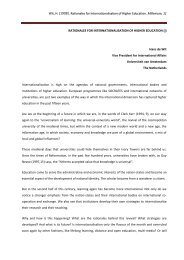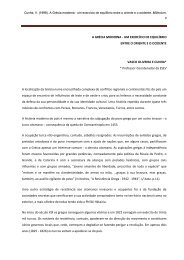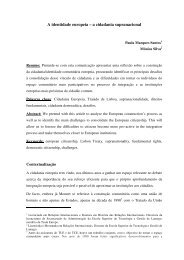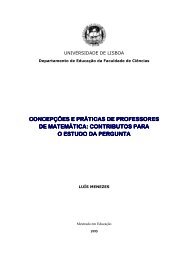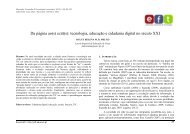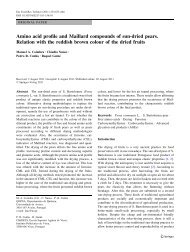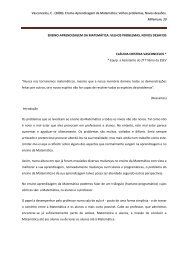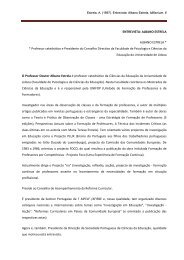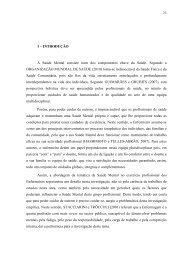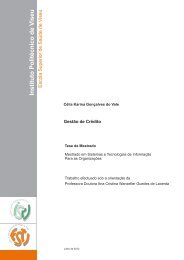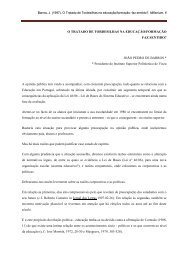COSTA Andreia Filipa Fonseca Cruz, Dissertação mestrado.pdf
COSTA Andreia Filipa Fonseca Cruz, Dissertação mestrado.pdf
COSTA Andreia Filipa Fonseca Cruz, Dissertação mestrado.pdf
You also want an ePaper? Increase the reach of your titles
YUMPU automatically turns print PDFs into web optimized ePapers that Google loves.
ABSTRACT<br />
The Pressure Ulcers are currently pointed out in the scientific literature as a complex<br />
problem caused by multiple factors, which involves high costs both at individual, family and<br />
socio-economic level. Moreover, taking into account that its prevention is an indicator of<br />
quality in nursing care and that the Trauma Victim involves a high risk of developing<br />
Pressure Ulcers, the relevance of the research "Development of Pressure Ulcer in a Trauma<br />
Victim " becomes explicit.<br />
This is a retrospective, observational, descriptive and co relational study , whose<br />
objectives have been outlined in order to obtain scientific and valid answers to the research<br />
questions: to determine the prevalence of Pressure Ulcers in a Trauma Victim; to identify<br />
factors predisposing to the development of Pressure Ulcers in a Trauma Victim. To achieve<br />
them, a non-probability convenience sample was used; this sample consists of individuals<br />
admitted to the Department of Orthopedic Surgery, Hospital Infante D. Pedro, Aveiro,<br />
between January 1 to December 31, 2010, a total of 500 trauma victim participants. Data<br />
were collected from the computer system, based on a clinical scale.<br />
Through the results analysis we can conclude that the prevalence of Pressure Ulcers<br />
in a Trauma Victim is 4%, considering that the factors predisposing to the development of<br />
Pressure Ulcers are: the Trauma Victims advanced age (U = 2422.00, z = -3,756, p =<br />
0.000), longer period of hospitalization (U = 2562.50, z = -3,549, p = 0.000), lower<br />
diastolic blood pressure (U = 2618.50, z = -2,115, p = 0.034), higher pain intensity (last<br />
evaluation) (U = 2940.00, z = -1,978, p = 0.048); self-care dependency: eating and drinking<br />
(χ 2 = 12,614, p = 0.000); presence of diabetes mellitus (p= 0.000); presence of diabetes<br />
mellitus: insulin-dependent (p = 0.033), the fact that the patient has urinary catheter at<br />
admission (p = 0.025) ; the need for placement of urinary catheter during hospital stay<br />
(χ 2 = 38,594, p = 0.000), use of diapers (p = 0.004), self- care dependency: hygiene and<br />
protection of teguments (χ 2 = 4,269, p = 0.039); presence of cutaneous tegument: dry<br />
skin (p = 0.046), need for physical restraint (p = 0.036), ); taking of antibiotics (χ 2 =<br />
9.197; p = 0.002);taking of anti-inflammatory pills (χ 2 = 8.704; p = 0.003) longer time since<br />
admission until the 1st application of the Braden Scale (U = 2899.50, z = -1,970, p =<br />
0.049) ; higher risk of Pressure Ulcer: first evaluation (U = 1539.50, z = -4,456, p =<br />
0.000) higher risk of Pressure Ulcer: last evaluation (U = 1487.50, z = -4,529, p = 0.000).<br />
The results suggest that the etiology of developing Pressure Ulcers in a Trauma<br />
Victim is multifactorial. Thus, we it´s highly relevant that the nurses consider the Trauma<br />
Victims age, the length of their hospital stay, diastolic blood pressure, amount of pain, self-




